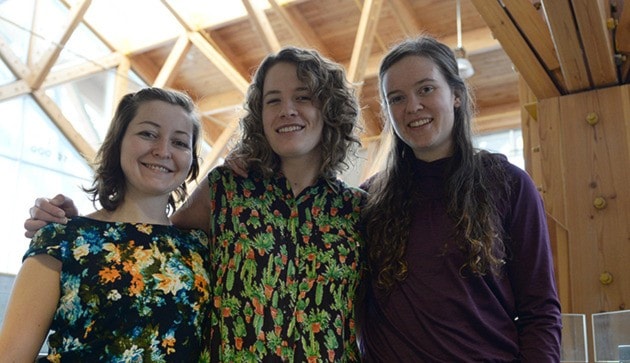A post-secondary student from Vanderhoof, in her last year of studies away from home, is applying her learning to local utility projects.
Kathleen Horita from Vanderhoof, along with fellow environmental engineering students Maureen Long and Allison Matfin from the University of Northern British Columbia, presented options for a potential new wastewater treatment facility to the communities of Fort St. James and Nak’azdli Whu’ten First Nation on Dec. 8.
Taking into consideration for each option its environmental footprint, the simplicity of operation, odour, the use of the resultant solids, potential energy recovery, water reuse, and the level of innovation, the study recommends a sequencing batch reactor, which uses microorganisms to treat the water through five stages, Horita explained.
It’s an option with the lowest operating cost, lowest per capita cost, with not many chemical and energy requirements, she said.
“Right now a lot of engineering projects are based on cost when they’re going forward,” Horita said. “It’s become a newer thing to assess them by the triple bottom line and look at the economic, social, and environmental benefits, and not basing everything only on cost.”
With multiple community consultations, the project included many opportunities to work closely with the affected communities and incorporate feedback into the final recommendation, she explained.
“It was interesting to see how much they care and what their input involved,” Horita said. “How educating them in what the options were and what they need to consider, and how that change their view of things.”
She added, “We got to really see what the environmental and social benefits and what’s important for the community to see for the wastewater treatment plant.”
Started in September and finished earlier this month, the study was an extracurricular project for the students, who are currently in the last semester of their environmental engineering degree, Horita said.
“It’s always useful to have actual legitimate engineering projects when you’re writing your resume,” she said.
With relevant previous coursework, the students had a background in wastewater management, and it’s the first time they researched wastewater treatment options in such a detailed depth, Horita explained.
“We learned there’s a lot of innovations that can be found with wastewater,” she said. “You can produce energy from it, you can recover heat from it, you can treat it and use it as fertilizer.”
She added, “There’s a lot of things you can do with waste that’s only recently coming to light, so it’s an interesting field of study.”
It’s the first time for the three friends to work together, though Maureen Long and Allison Matfin has previously worked together on a capstone project for the City of Kelowna’s wastewater management to culminate their degree.
Presenting a model that uses treatment processes similar to the sequencing batch reactor, the project won the BC Water and Waste Association’s annual student design competition in B.C., and third place in the international student competition with the Water Environment Federation Technical Exhibition & Conference in Chicago, this year.
For Nak’azdli Whu’ten First Nation’s Chief Operating Officer Nicholette Prince, who had first approached UNBC with the project and worked closely with the students, it was an opportunity for students to have some real life exercise in their learning, and gives the community a jumpstart on what is needed to change their wastewater treatment facilities, Prince said.
“I haven’t done this before, and didn’t know what to expect,” she said. “But they were so smart, so professional, so keen…they did a really good job.”
The project gives the students an opportunity to work with First Nation communities, and provided the community with the necessary background information to approach funders for a potential new facility, Prince explained.
Located within the boundaries of the Nak’azdli Whu’ten First Nation, the wastewater treatment lagoon for Fort St. James was first installed in the 1960s and occupies 27 acres of land, she said.
“It uses so much of our land,” Prince said, adding that the smell parameter of the lagoon extends far beyond, affecting more and more nearby residents as the community grows.
“It’s time to get rid of this lagoon,” she said, “We’ve been talking about it for years…and we decided to jump in [and look for a new option.]”
She added, “This is a great opportunity for local governments, and for students to work on more than theoretical projects.”
